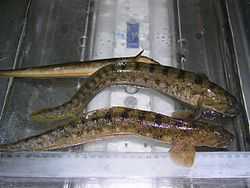Viviparous eelpout
| Viviparous eelpout | |
|---|---|
 | |
| Scientific classification | |
| Kingdom: | Animalia |
| Phylum: | Chordata |
| Class: | Actinopterygii |
| Order: | Perciformes |
| Family: | Zoarcidae |
| Genus: | Zoarces |
| Species: | Z. viviparus |
| Binomial name | |
| Zoarces viviparus (Linnaeus, 1758) | |
The viviparous eelpout (Zoarces viviparus), also known as the, viviparous blenny and European eelpout is an eelpout in the family Zoarcidae. It is notable for giving birth to live larvae (hence the description "mother of eels"). It is a common soup ingredient in Mediterranean countries. The bones are of greenish colour, due to a harmless pigment. Their skin is slimy and the color is variable.
Viviparous eelpouts grow to a maximum length of 52 centimetres (20 in) and a maximum weight of 510 grams (18 oz). They typically live at water depths up to 40 metres (130 ft). The fish live to a maximum age of 10 years.
Description
The viviparous eelpout has a slim, tapering body and resembles a small burbot (Lota lota), a wide head and mouth and protuberant lips. It has long, ribbon-like dorsal and anal fins which continue on to unite with the arrowhead-shaped caudal fin. This distinguishes this fish from the two similar slim-bodied bottom-dwelling fish of the area, the rock gunnel (Pholis gunnellus) and the snake blenny (Ophidion barbatum). The average size of this fish is about 20 to 30 cm (7.9 to 11.8 in). It is a brownish color with irregular dark brown markings and a yellowish belly. The pectoral, anal and caudal fins are tinged with orange which becomes a more intense hue during the breeding season. The bones are green.[1]
Distribution and habitat
These eelpouts live in a temperate climate in the marine waters of the Northeast Atlantic including the seas such as the Baltic, Barents, Irish, North, and White Seas. They also live in some brackish inlets, such where the River Somme meets the English Channel. The fish stay towards the rocky shorelines and tidepools among the stones and algae. The fish are capable of living out of water under rocks and seaweed due to their ability to breathe air directly. The fish eat eggs and fry of fish and macroinvertebrates such as gastropods and crustaceans.

Biology
The viviparous eelpout feeds on bottom-dwelling invertebrates, such as crustaceans, and fish eggs and fry.[1]
Adults mate during the months of August and September using internal fertilization. The fish are notably viviparous, giving birth to 30–400 live developed young. Unusually, it does so during winter when water temperatures are extremely cold. Among fish it has one of the longest known pregnancies, lasting approximately six months. It has been discovered that the eelpout suckles its young embryos while still within their mother's body, making it the only fish species to suckle its offspring. The embryos actually suckle from ovarian follicles, ingesting nutrients and gases from these internal structures. After depleting the egg's yolk reserves, the eelpouts attach their mouths to an ovarian follicle, which has a canal in its tip via which fluid and nutrients can flow. This follicle fluid is rich in proteins, fatty acids and glucose. It is also saturated in oxygen, which helps ventilate the gills of the developing fish. Each embryo latches onto a single follicle. This ensures an equal distribution of nutrients.[2]
References
- ↑ 1.0 1.1 "Viviperous blenny: Zoarces viviparus (L.)". NatureGate. Retrieved 2013-12-19.
- ↑ Matt Walker (September 28, 2010). "Pregnant European eelpout fish suckles young embryos". BBC News. Retrieved September 29, 2010.
- "Zoarces viviparus". Integrated Taxonomic Information System. Retrieved June 23, 2005.
- Froese, Rainer and Pauly, Daniel, eds. (2005). "Zoarces viviparus" in FishBase. May 2005 version.